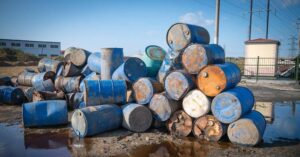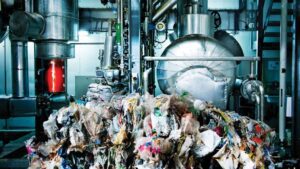Fashion Impact in Environment and Society
Fast fashion has a significant negative impact on the environment and society. Fast fashion production requires large amounts of energy, water, and chemicals, which can lead to pollution and other forms of environmental degradation.

Additionally, many fast fashion companies use sweatshop labor, which can lead to poor working conditions and low wages for workers. The constant turnover of styles and the pressure to produce new clothing quickly also lead to a lot of textile waste.
Moreover, synthetic fabrics, which might take hundreds of years to disintegrate in the environment, are frequently used to make fast-fashion clothing. This adds to the global environmental catastrophe of plastic pollution. Fast fashion is generally unsustainable and can have serious negative effects on the environment and the people who manufacture and wear the clothing.
Water
Due to its extensive water use, the fast fashion business has a negative influence on both society and the environment.

The production of textiles, particularly cotton, is water-intensive, and fast fashion companies often source their materials from countries with scarce water resources. This can lead to water scarcity and depletion in those areas. Additionally, using synthetic materials in fast fashion contributes to water pollution by releasing microplastics and chemicals into waterways. Fast fashion also contributes to social issues, as it often involves exploitative labor practices and poor working conditions in textile-producing countries.
Pollution
Pollution from the fast fashion business has a severe influence on the environment and society. The production of textiles and clothing generates significant amounts of pollution, including the release of chemicals and microplastics into the air and water. The use of synthetic materials, such as polyester, in fast fashion, contributes to the release of microplastics into the ocean, which can have harmful effects on marine life and ecosystems.
Additionally, the manufacturing process for fast fashion often involves the use of hazardous chemicals, which can lead to water and air pollution and can also harm the health of workers who are exposed to them.

Furthermore, the fast fashion industry is also responsible for pollution from transportation, as garments are often shipped long distances from where they are produced to where they are sold, resulting in a high carbon footprint. This contributes to climate change and air pollution.
Fast fashion also contributes to social issues, as it often involves exploitative labor practices and poor working conditions in textile-producing countries, which can lead to negative impacts on the health and well-being of workers.
Energy
By consuming so much energy, the fast fashion business has a substantial negative impact on both society and the environment. The production and transportation of textiles and clothing require large amounts of energy, which can lead to increased greenhouse gas emissions and contribute to climate change. The process of growing, harvesting, spinning, and weaving raw materials into textiles, such as cotton, also consumes a lot of energy.

Fast fashion companies often outsource their production to countries with cheaper labor and less strict regulations, resulting in outdated and inefficient production methods that consume more energy than modern techniques.
Additionally, the frequent release of new collections and styles by fast fashion companies increases the energy consumption and emissions associated with the production and transportation of new garments.
Fast fashion also contributes to social issues, as it often involves exploitative labor practices and poor working conditions in textile-producing countries, which can negatively impact the health and well-being of workers and the communities they live in.
Chemical usage
Through the usage of chemicals, the fast fashion sector has a huge influence on the environment and society. The production of textiles and clothing requires the use of a variety of chemicals, including dyes, bleaches, and finishes, which can have negative impacts on the environment and human health. These chemicals can be released into the air and water during manufacturing, leading to pollution and contamination of nearby communities and ecosystems.

The use of synthetic materials, such as polyester, in fast fashion, also contributes to the release of microplastics and chemicals into the ocean and other water bodies. The chemical pesticides and fertilizers used in growing cotton, another common fast fashion material, also cause pollution and contamination of soil and water resources.
The exploitation of labor in fast fashion production facilities also leads to poor working conditions, including exposure to hazardous chemicals, which can have negative impacts on the health of workers and their families. The chemicals and dyes used in fast fashion production can also lead to skin and respiratory issues, headaches, and other health problems for workers.
Social impacts
The fast fashion business has a major impact on society through labor practices and working conditions. Fast fashion companies often outsource their production to countries where labor is cheaper and regulations are less strict, resulting in exploitative labor practices and poor working conditions for workers. This can include low wages, long working hours, lack of benefits and safety measures, and poor housing conditions.

Workers in fast fashion production facilities are often subject to verbal and physical abuse, discrimination, harassment, and lack of representation and labor rights. This can lead to negative impacts on the health and well-being of workers and their families, as well as their communities.
Fast fashion also contributes to social issues such as forced labor, child labor and human trafficking. Many fast fashion companies do not have transparency in their supply chains, making it challenging to ensure that workers are treated fairly and ethically.
Additionally, fast fashion also contributes to environmental issues like pollution and water depletion, which can also have an impact on the well-being of communities, especially those living in proximity to textile production facilities.
Waste creation
From the fabrication of waste, the fast fashion business has a huge negative influence on the environment and society. The constant release of new collections and styles by fast fashion companies results in a high turnover of clothing and a culture of disposability, leading to an increase in textile waste. The constant change in trends and low prices of fast fashion garments encourage consumers to buy more and dispose of clothes quickly, leading to a high rate of clothes sent to landfills, incineration, or dumped in the environment.

The production of textiles and clothing also generates significant amounts of waste in the form of scraps and offcuts, which can contribute to pollution and deforestation. The use of synthetic materials, such as polyester, in fast fashion, also creates waste, as these materials do not biodegrade and can persist in the environment for hundreds of years.
Fast fashion also contributes to social issues, as the waste created by the industry can have negative impacts on the health and well-being of workers and communities living near textile waste disposal sites. The communities in these areas can suffer from environmental pollution, and health hazards caused by the toxic chemicals and dyes used in textiles production.




